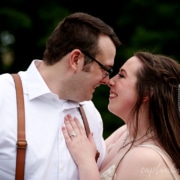Part Two: An Overview for Selecting and Securing Your Wedding Photography
You can approach this process in a number of ways, depending on what’s most important to you: hiring your preferred photographer or securing your preferred location. If it’s the photography that means the most to you, then contact your preferred photographer first. If you are more concerned about the location, then that is the best place to start. Of course the further in advance you plan, the better the chances of securing both preferences. This process is much like piecing together a puzzle and there is no right way to go about it. Take comfort in knowing that you can weigh all of the aspects involved and make your decision based on the factors that matter most to you.
The availability of your photographer, ceremony and reception location are primary concerns. Factors involved in these decisions are your bridal party, guest list and budget. Disc jockeys or other entertainment may also be a primary concern. The dress, flowers, invitations, etc. may be the most enjoyable decisions you’ll make regarding your wedding, however these are secondary concerns. Again, this can be overwhelming if you think about all of the decisions at once, so I suggest focusing on the primary concerns first. Wedding planners can be very helpful in this case—not to mention their role of ensuring all the details are attended to on the day of your wedding.
Once you determine if the photographer you’re interested in hiring is available, it is generally a good idea for you and your fiancé to meet with the photographer. This allows you the opportunity to get a feel for the photographer’s personality. Even though you’re not paying for their personality, it plays a major role in the tone of your day. An overbearing personality can be particularly upsetting on this often-emotional day. In addition to getting to know this person, you can ask about their packages and contract, view samples of their work and discuss the schedule for your wedding day, particularly the timing and location for formal portraits and the post-ceremony photo shoot.
Most photographers require a retainer fee or down payment to reserve your date. And a contract is essential for all parties involved to document the agreement of services, products and fees. A liability clause is often included in wedding photography contracts and should detail the terms of responsibility in the case of an emergency (casualty, illness, act of terrorism). Should an emergency arise, make sure the clause details are satisfactory. For instance, does the clause ensure an alternate photographer with the same skill level?
If you’re having trouble making a decision, an engagement session is a low-risk way to determine if a photographer is right for you. Plus, family members love receiving photos of their newly engaged relatives. On-location engagement sessions offer a creative alternative to the standard poses in a studio.
After signing a contract, you can expect your photographer to be in touch again at about one or two weeks prior to your wedding to go over the schedule of the day and any other new details that were not discussed during your introductory meeting. Some photographers do this by phone while others prefer to meet in person. Either way, this can be helpful in relieving any concerns you may have about your photography prior to your wedding day.

 Captivating Imagery
Captivating Imagery

Leave a Reply
Want to join the discussion?Feel free to contribute!